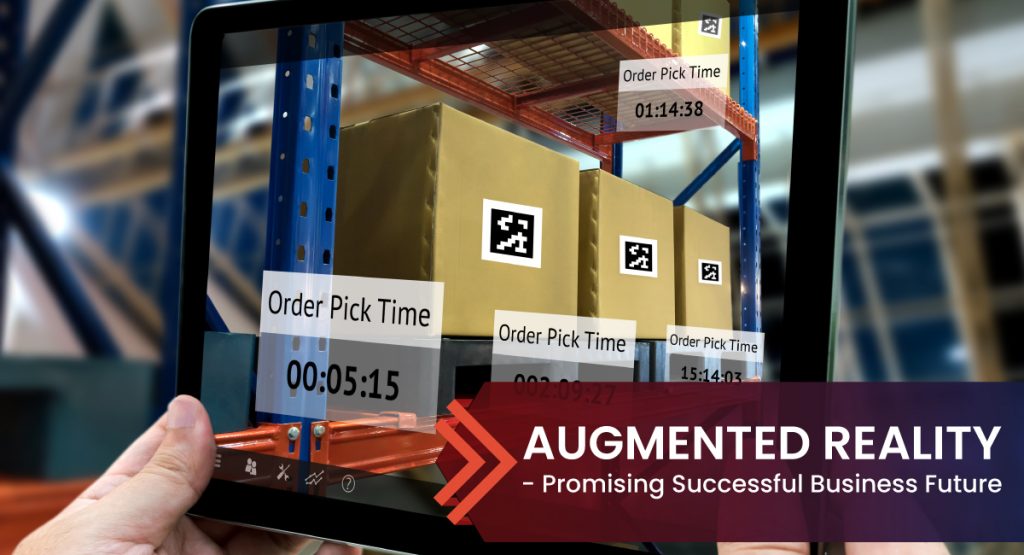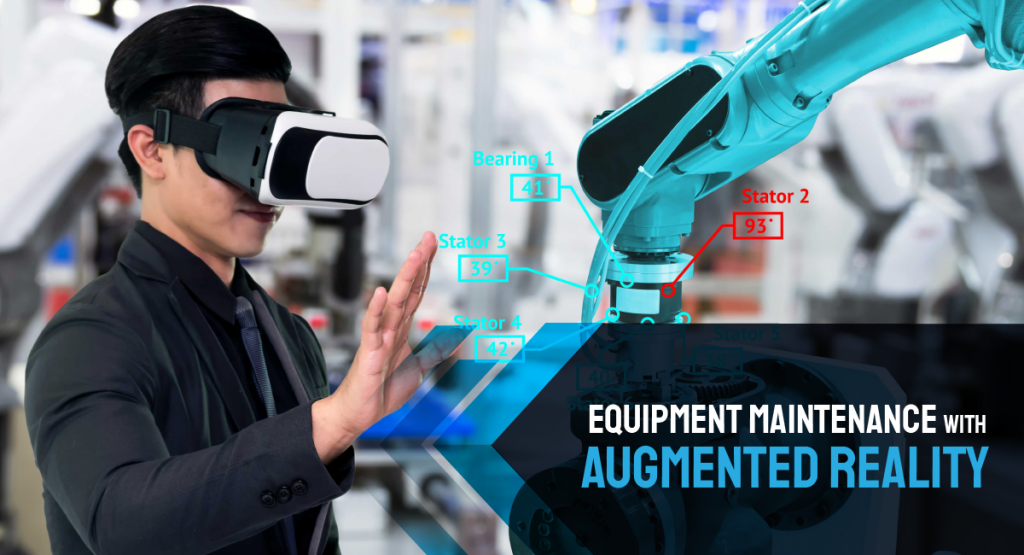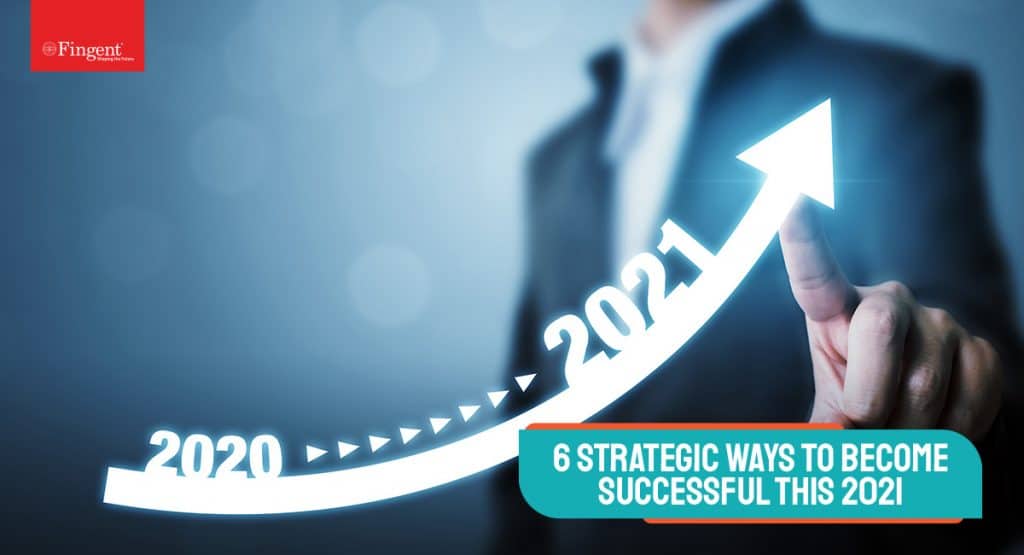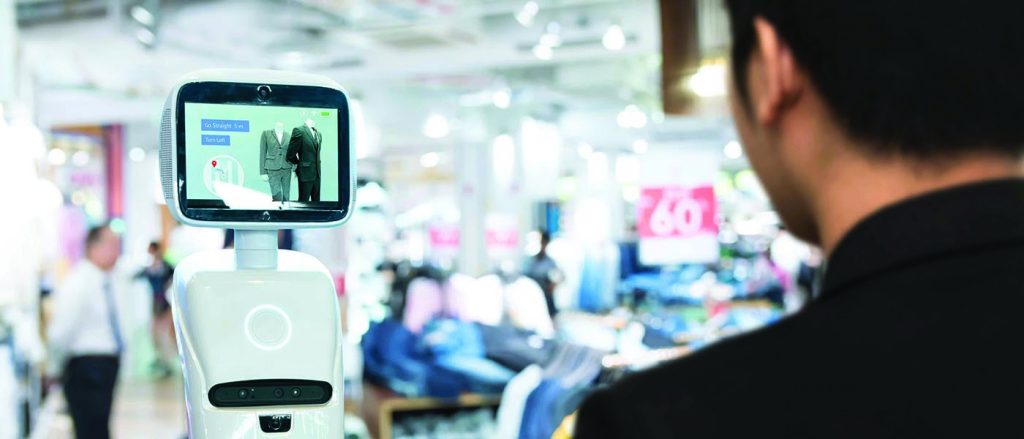Category: e-Commerce
How Various Industries are Leveraging AR, VR, and MR Today?
Augmented Reality (AR), Virtual Reality(VR), and Mixed Reality (MR) may sound the same to many of us. But do you know that each one is different? AR, VR, and MR are different tech concepts with characteristics that differentiate each from one another.
Here’s what you need to know about each of the technologies, along with a few examples.
Augmented Reality
Augmented Reality uses computer vision along with mapping and depth tracking to show the appropriate content to the user. This functionality allows the cameras to collect, send and process the data to show the appropriate content to the user.
AR is designed for unrestricted movement while projecting images or other objects that you are looking at and enhances the user’s physical environment with contextually relevant digital content in real-time. A user can experience Augmented Reality with a smartphone or special hardware.
Watch Video: Augmented Reality in Education Transforms Learning Experience
Some of the interesting real-world examples of AR
1. AR in Gaming
Games like “Pokemon Go” project a Pokemon on your screen, on top of whatever your mobile camera focuses on. Augmented Reality has beautifully combined the real world with the favorite Pokemon characters.
2. AR in Medical Training
Augmented Reality is finding its virtue in medical training today. For example, students at the Cleveland Clinic, Case Western Reserve University are learning human anatomy using AR headsets or glasses. AR allows them to examine the human body without the need for dissecting cadavers or watching live operations.
Read more: How Augmented Reality in Healthcare is set to Transform the Industry in Future
3. AR in Retail
The retail sector also has been taking advantage of AR to help customers have a more enjoyable and interactive shopping experience. For example, Harley Davidson has developed a unique mobile app for its customers that allows them to view a motorcycle in-store using AR and customize it by adding accessories, changing paint jobs, etc.
IKEA, the leading retail conglomerate, has rolled out AR-powered retail apps that allow customers to “try on” clothing remotely before buying them online.
Read more: How Top Brands Embrace Augmented Reality to Offer Immersive Customer Experiences
4. AR in Manufacturing
Augmented Reality enables the manufacturing industry to gain a competitive edge by helping companies improve quality and productivity. Workers can get assistance from AR gadgets to save time, reduce errors and increase efficiency. Some of the world’s biggest brands like Boeing and General Electric are already using AR in their manufacturing processes.
Using AR glasses allows Boeing’s technicians to easily view the wiring renderings in the aircraft fuselage without external distractions.
Augmented Reality enables GE mechanics to be more productive as the technology offers them step-by-step instructions and visuals directly within their line of sight. They also get alerts in real-time through AR smart glasses so that they can inspect every step before moving on.
Read more: How Augmented Reality Simplifies Equipment Maintenance
Virtual Reality
Virtual Reality Environments (VREs) allow users to experience real-life scenarios via simulated counterparts and gain practical knowledge that would otherwise be difficult to comprehend in a real environment.
As the main focus of Virtual Reality is on simulating the vision, you will have to wear a VR headset such as Oculus Quest or HTC Vive Cosmos in front of your eyes that eliminates any interaction with the natural world (avoids distractions). Typically, two autofocus lenses are placed between the screen and the user’s eyes. The lenses adjust based on the individual eye movement and positioning. To render the visuals on the screen, you can use an HDMI cable connected to the PC or mobile phone.
Virtual Reality uses speakers, goggles, and even handheld wearables to simulate a real-world experience. You can also employ visual, audio, and touch simulation to create a more immersive reality.
A few real-life applications of VR
1. VR in Education
Virtual Reality can make learning more engaging and immersive. In addition to schools and universities, virtual experiences can help businesses train their staff. Currently, Unimersiv is offering VR educational content for institutions and companies.
Case Study: Using 360-degree VR simulations, the University of North Carolina offers an immersive campus touring experience to aspiring students. Download now!
2. VR in Real Estate
For years, real estate agents have used photos and graphic designs to showcase properties to prospective buyers. Today, Virtual Reality has transformed real estate property tours, making them more personalized, immersive, and close to reality. Being an immersive technology, VR enables potential buyers to experience a 3D walkthrough and understand better what each property has to offer even before scheduling a physical site visit.
For example, Sotheby’s, one of the world’s leading luxury realty brands, offers Virtual Reality home tours and videos to its clients. Potential buyers can view properties and spaces from the comfort of their homes using a web browser, or a smartphone, PC, laptop, or through a wearable headset.
Read more:How Virtual Reality can Transform Your Real Estate Business
3. VR in Marketing
VR is helping businesses reach out to their audiences by launching immersive and engaging marketing campaigns. With the COVID-19 pandemic compelling people to shop online and companies to transform digitally, Virtual Reality is gaining more popularity as it is helping people get a feel for products without leaving their homes.
For example, IKEA has introduced a VR app that enables users to experience kitchen remodeling. Using the VR Kitchen app, you can explore the virtual kitchen and interact with the objects using a VR headset.
4. VR in Healthcare
Virtual Reality helps doctors understand their patients’ needs better as it provides an in-depth look into human anatomy. Today, VR is extensively used in surgical training.
An educational project conducted by the University of New England (UNE) successfully used VR to teach empathy to medical and health profession students. The project used a VR tool called “Alfred Lab app” – to teach students about macular degeneration and hearing loss from a 74-year-old African American man’s perspective. Realizing an aged and ailing patient’s thoughts and concerns enables the residents to develop empathy towards such patients.
Read more: How Virtual Reality Improves the Standard of Medical Education and Training
5. VR in Travel and Hospitality
The travel industry is facing the hardest time ever in its history. However, vaccination rollouts on a global scale and international travel relaxations now give a fillip to travel, tourism, and hospitality. An early adopter of digitalization, the travel industry has already forayed into Virtual Reality. Travel businesses attract tourists and even promote holiday destinations through virtual staging and tours. Virtual Reality also allows people to explore the world virtually, especially those who cannot afford to travel.
Google StreetView is one of the best examples of how VR is being used in the travel industry. In addition to viewing panoramic images on a computer, it allows users to enable Google Cardboard mode for a Virtual Reality experience.
Mixed Reality
Mixed Reality, sometimes known as hybrid reality, combines the elements of both AR as well as VR. However, here the virtual content is not only overlaid on the actual environment but is fixed to and interacts with that environment. In simple terms, Mixed Reality lets you see virtual objects just like Augmented Reality, but these objects are capable of interacting with the real world. In simple words, Mixed Reality is more like immersive and interactive Augmented Reality.
MR is still in its nascent stages and may take time to create an impact like the other two technologies. One of the most remarkable Mixed Reality apparatuses is Microsoft’s HoloLens.
Opportunities provided by Mixed Reality
1. MR in Education
Mixed Reality allows students to see both the real world as well as the holograms. MR offers an immersive learning environment enabling students to understand better.
Case Study: Find how Fingent developed a unique Mixed Reality application for a leading university that enables users to identify people using facial recognition. Download Now!
2. MR in Manufacturing
Mixed Reality provides workers with real-time assistance, thereby facilitating manufacturing processes. The technology allows workers to see holographic instructions, so they know what to do. This minimizes human errors and improves quality significantly. Mixed Reality is also helpful for repairs and maintenance, especially in industries that require precision and expertise.
For example, Renault Trucks integrates Mixed Reality into its manufacturing process for enhancing engine quality control at one of its factories.
The blurring line between physical and virtual
While Virtual Reality takes you to the virtual world from wherever you are, Augmented Reality adds to the reality by projecting information on top of what you see. Mixed Reality combines both AR and VR. All these technologies, though powerful, are yet to make their mark with consumers. That said, they can completely change the way we use computing devices, gadgets, and technology in the future.
Are you thinking about delivering immersive virtual experiences to your customers that can overtake physical encounters? Talk to our reality tech experts today.
Stay up to date on what's new

Featured Blogs
Stay up to date on
what's new



Talk To Our Experts
Add More Zest to Your Ecommerce Marketing and CX with 3D Web Configuration
Having a digital infrastructure is inevitable, but it just isn’t enough to keep up with the competition. Achieving business success is about “wowing” your e-commerce buyers. In the post-pandemic world, businesses must find engaging and innovative ways to increase customer satisfaction and experience. A recent Frost & Sullivan study showed that by 2020, customer experience would overtake price and product as a key brand differentiator. True to this, business in 2020 was entirely driven by customer experience.
View Infographic: Business Technologies to Boost Customer Experience and Satisfaction
Local shoppers switched to online shopping, door deliveries were encouraged, telemedicine became more popular, mobile and internet banking users increased, and even classrooms became virtual.
So, how do you “wow” your customer in this age of online shopping? By giving them as close to the real experience as virtually possible!
How do you do that? With a 3D configurator!
A 3D product configurator allows your customers to see exactly how your product looks, acts and feels. It gives them a personal connection with their potential purchase. 3D configurators have become an integral part of the sales process and rising customer expectations during the pandemic, making it vital for specific industries.
This blog helps you understand what a 3D web configurator is and how it can help increase your e-commerce sales and boost customer satisfaction.
Read more:How Custom Retail Software Solutions Help You Gain a Competitive Advantage?
What is a 3D Web Configurator?
In the past, customers were satisfied to see a static photograph that they could easily zoom in and out. However, with the changed circumstances and digital development, customers would like to view how various product designs or features would look in real-time, allowing them to spin, zoom, scroll, and rotate. That is precisely what a 3D web configurator allows your customers to enjoy.
A 3D web configurator is defined as an interactive tool powered by 3D models that lets your customers personalize a product to their specifications in real-time. Plus, it allows them to choose custom options and watch them transform instantly, and receive estimates of the costs based on their customizations.
This service gives your customers the feel of being at your store because it gives them the ability to get the feel of the product, such as the color, texture, and other aspects of your product. Customers can watch it from any device without using plugins.
Essentially, 3D configurators are not just for retailers and car companies. All industries that sell customizable products can benefit from letting their customers see how their products look in real-time. Once this service is implemented, you can increase your ecommerce sales and boost customer satisfaction.
Read more: 6 Ways to Accelerate Business Growth and Success in 2021
How does a 3D Web Configurator Work?
A 3D web configurator accomplishes two pertinent e-commerce goals:
- A detailed exploration of your products
- The ability to customize the product to a customer’s specific needs
When your customers have not zeroed in on a particular product, your 3D configurator steps in to display different combinations and options for that product to inspire them to make an informed decision. In effect, your 3D configurator will help them check out the colors, styles, material and combine them in different ways until they create a personalized product. Then, as they mix and match their specifications, your configurator will allow them to see their combinations in 360-degree, in real-time mode, along with the price. Such precise control over their product will encourage them to make a purchase.
Read more: How Top Brands Embrace Augmented Reality to Deliver Immersive Customer Experiences
How 3D Web Configurators Boost E-Commerce Sales and Customer Satisfaction?
1. Enable omnichannel experience
As mentioned at the outset, 3D configuration solutions do not require a third-party plugin which limits the number of customers who can view your product. Above all, it can be formatted for events or used in interactive stores as it can also work offline. Such interaction encourages your customers to participate in your productions, ensuring you understand their choice and budget.
2. Grow your e-commerce sales
Your customers will have proactive control of what they want to buy as 3D configuration solutions allow them to try out various combinations virtually. Once you know their exact requirements, you can minimize errors, misunderstandings, and mistakes between you and your customer.
3D web configuration reduces barriers to the market as you will be able to release the options to your customers during the first stage of product development. Thus, you can grow your e-commerce sales as your customers know that you understand them clearly and provide them with quality products.
3. Save costs
3D web configurators can redefine and shorten the sales cycle as real-time customer responses/ reactions can help you create better outcomes. This allows you to track consumer behavior in real-time. Also, you can reduce the quantity of raw materials you need to stock as you will now create products as per request.
Furthermore, you can minimize significant expenses incurred in logistics and storage to a great degree. You can also personalize this unmatched 3D technology to become as responsive as the rest of your website.
4. Place your customers behind the wheel
As the factory floor entered the digital age, brands must let their customers take the driver’s seat for tremendous success. Only then will you precisely understand what your customers want. Knowing that will help you meet their demands accurately. The 3D web configurator allows your customers unparalleled freedom to bring their dream product to life, ensuring their satisfaction.
5. Distinguish your brand with a “wow” factor
Consumer attention has created intense competition between brands, forcing them to spend billions in an attempt to find the magical ingredient that will capture and retain the attention of their customers.
What determines whether their attention sticks or moves away is the “wow” factor that keeps them returning for more. A 3D configurator will help you ensure that your customers are “wowed” each time they visit your website because they would have truly enjoyed the experience. Your configurator can boost customer satisfaction by delivering the experience needed to attract and amaze your customers repeatedly.
6. Boost sales
3D web configurators increase conversion rates and revenues as your customers can make informed decisions without delay. It gives them all the information they require to make a quick purchase. For example, it offers details such as customization of the product, price, immediate and direct contact with the salesperson, detailed descriptions, and a strong call to action. Additionally, you can avoid cart abandonment scenarios through increased engagement.
Make 3D Web Configurators Your Launching Pad
Customer engagement and interactive product visualization can customize a product of choice and provide a tangible in-store experience to your online customers. It can become a launching pad for increased growth, higher sales, and conversions. Would you like to experience the power of a 3D web configurator and don’t know where to start? Get in touch with us right away.
Stay up to date on what's new

Featured Blogs
Stay up to date on
what's new



Talk To Our Experts
How e-commerce adoption benefits B2B healthcare providers and device makers
The healthcare and life sciences industry is expanding at an exponential rate. The complexity and regulatory nature of the industry have made it imperative that technology catches up with its pace and offers solutions to meet this expansion. This need is being felt more acutely at the moment with the COVID-19 pandemic on the loose. As the pandemic spreads its poison and puts the B2B healthcare and life sciences e-commerce market into a state of flux, it forces large and small organizations to cope with a range of problems that include difficult purchase decisions, supply chain disruptions, and fulfillment and delivery issues. This calls for a technological solution tailored to suit the B2B healthcare and life sciences industry.
With over 17 years of experience in delivering customized technological solutions including developing e-commerce platforms for B2B clients, we provide B2B e-commerce web application development services for manufacturers, wholesalers, distributors, and so on. Also, our mobile app development services specialize in the designing and development of custom B2B e-commerce apps.
Case Study: Fingent’s solution for our client Bonanza – Streamlining Online Listing and Inventory Management
In this article, we will explore five specific ways in which B2B e-commerce is that solution and how it will transform healthcare and life sciences.
Immediate and lasting impact on the B2B e-commerce market
In the present scenario, especially from a healthcare and life sciences manufacturing and supply perspective, the impact is immediate throughout the entire supply chain. Manufacturing companies are unable to keep up with the demand, and distributors are rushing to create workflows in an attempt to mitigate customer complaints. Distributors are being forced to claw their way to the front of the line to obtain supplies from manufacturers, stock up on products, and take care of their customers.
Healthcare and life sciences organizations typically have disaster preparedness plans, but dealing with such an unprecedented disaster is another ball game altogether. The question has shifted from purchasing to inventory, from buying to stocking. It makes it challenging to find the space to hold extra products that these industries may need and that causes anxiety to all parties within the supply chain.
B2B e-commerce offers irresistible opportunities for purchasers and medical suppliers
B2B e-commerce works largely on a distribution-based model where customers get their supplies from local distributors or dealers. Thus far, e-commerce has been disrupting the offline system of the B2B industry at a slow pace. However, with the spread of coronavirus and the subsequent lockdown, various industries including healthcare and life sciences are switching to online buying options to prevent human contact. This has resulted in B2B e-commerce experiencing an unprecedented boost in traffic and sales in just a matter of a few weeks.
Read More: Contactless Retail Delivery Software – How Retailers Can Revive Sales While Adhering To Social Distancing Norms
While buyers turn to an online purchase, many suppliers have adapted their strategy to foster online sales, dedicating a certain amount of their budget to digital marketing and communications. The current pandemic is imposing digitization of all B2B businesses that would help to communicate with the buyers and generate sales. Digitization of the supply chain is a crucial aspect of e-commerce because it encourages transparency and shows real-time availability of goods right from the manufacturers to the buyers. This makes it extremely important for suppliers to implement digitization in their supply chain.
The present COVID situation has forced most suppliers to work from home. Those who have already been using digital media are able to manage work remotely. However, others need to think over and plan to reform their business model to adapt to the new era of e-commerce. The pandemic might be temporary, but this trend is not going to be! This is a breakthrough that will continue far into the future. Now is the best time to be innovative, leverage the benefits of the latest digital technology, data analytics, and AI and unlock the potential of digitalization and e-commerce in B2B business. An advanced e-commerce solution built on the latest technology facilitates seamless interactions online across marketing, product discovery, sales, and post-sale service in the B2B sellers’ space.
Read More: E-commerce ERP Software
Five ways B2B e-commerce can be transformative
As B2B e-commerce forges ahead, the healthcare and life sciences industries will prove to be faster adopters than others. They can fully leverage real-time data tracking inventory and logistics between buyers and sellers. For manufacturers and distributors who sell to hospitals and nursing homes, the level of information presented to buyers in the B2B space can depend on the size of the organization or the customer that is doing the transaction. Depending on the frequency of the order, the level of sophistication of information may vary. Shifting to B2B e-commerce will prove to be a much-needed transformation.
Here are five ways that this transformation will be seen:
1. Online Shopping Drives Online Presence
E-commerce is changing the way people and end-users (such as doctors) shop for healthcare products and the way those products reach the hands of customers. Instead of visiting a pharmacy, most customers are turning to the internet to perform the functions of a regular pharmacy. Healthcare and life sciences companies use a business model that features quick delivery to a patient’s door or to hospitals and healthcare centers. Investors see promise in this revolutionary approach to medication fulfillment, demonstrating that the market has confidence in this model despite the shifting healthcare and life sciences landscape.
With more and more people turning to the internet to access products and medical care, the healthcare and life sciences industries have been increasingly concerned with the quality of their online presence. According to an online medical marketplace, 50% of their customers are referred by their primary provider or by hospital staff, and 20% are referred by family or friends. This highlights the need for the healthcare and life sciences industries to increase their online presence and maintain it.
2. Helps explore new possibilities while cutting costs and time
Shifting to an online B2B e-commerce process can help businesses recover 25-30 percent of their investment. Some of the more mature players might even see higher returns of their business through online orders.
Migrating more orders online frees up time for sales reps. They can concentrate on introducing new products and capitalize on opportunities for new business. This allows industry leaders to use their time and ability to explore new channels of business and revenue streams. This can also help expand their client base and move into new markets.
B2B e-commerce enables the healthcare and life sciences companies to see where the business is coming from, where the segments are online and where they are offline. It also gives them the ability to offer variable discounts with certain customers, on certain products, or even just one customer. It will make drug prices more transparent and market-oriented.
Read more: Odoo E-commerce – 5 Reasons to Integrate Your E-commerce Application with Odoo ERP
3. Transforms Logistics Operations
Synchronization of logistic operations is critical for the success of any business. Enterprise customers generally look for reliability, speed, traceability, and convenience in delivery along with effective product returns, and exchange policy of damaged products.
Technology solutions for B2B e-commerce provide orchestration with an application that is to be hosted on an e-commerce website. The open standard in these applications facilitates information exchange that allows real-time visibility for seamless integration across supply chain stakeholders. E-commerce offerings can provide credibility and trust for transactions between companies involved in the supply chain.
4. Enables Customer Personalization
B2B e-commerce enables customer personalization. Enterprise customers want personalized solutions. B2B e-commerce provides a customer portal with content organized around the parameters of their past purchase history and price optimization algorithms that are adjusted on the basis of the relationship. E-commerce offerings are simple, flexible, and convenient. B2B players can use a comprehensive suite of tools that are available to help their customers navigate the site. Certain platforms incorporate live online support to assist with any queries or issues which can improve conversion levels and facilitate buying decisions.
5. Sheer Momentum
Many medical device companies are already selling products online to enterprise customers. The healthcare and life sciences market is ripe for disruption. Medical device manufacturers and pharmaceutical companies will continue to deliver to wholesalers and distributors, but e-commerce allows them to embark on direct-to-patient delivery. Logistics is ready to respond with tailored services for various products. B2B e-commerce is set to propel healthcare and life sciences forward in the extremely near future.
Take Action
Ultimately, healthcare and life sciences e-commerce will facilitate the redistribution of stakeholders’ offline enterprise transformation and reconstruct all the links of the value chain. Realizing the benefits of B2B e-commerce, many healthcare and life sciences companies are becoming believers.
Read more: Top 5 Open-source ERP Systems for Medical Equipment Suppliers
E-commerce can effectively optimize operating processes, reduce costs, manage resource allocations, and address the increasingly diversified consumer healthcare demands. The healthcare and life sciences companies must understand that due to the conditions of accelerated technology change, it has become critical for enterprises to become more skilled in deciding their future course and be firm in taking action. If you need help with this, we at Fingent are here to help you take that next step. Get in touch with us and just let us know what you need.
Stay up to date on what's new

Featured Blogs
Stay up to date on
what's new



Talk To Our Experts
Disclaimer: The contents of this article reflect the opinion of the author and do not represent Fingent’s view about Facebook’s or Google’s policies
The latest advertising policy from Google and Facebook on cryptocurrencies has been hailed by users, media and even those in the cryptocurrency industry. It is easy to understand why.
Advertising, in itself, is unpopular.
The constant badgering of advertisements on social media, together with the exaggeration of product benefits has led to a lack of trust between advertisers and consumers. With every other cryptocurrency promising to be the next Bitcoin, users on Facebook and Google will be happy to see fewer advertisements promising instant riches and get rich quick schemes. Indeed, cryptocurrencies and ICOs have been viewed, as a fool’s gold.
Like any nascent tech sector, the cryptocurrency area is extremely unregulated, offering an avenue for fraudsters to take advantage of investors.
“Pump and dump” schemes, a testament to greed and naiveté, have made few people wealthy at the expense of many who bought into the utopian “get rich quick” dreams and “mathematical guarantees” offered by cryptocurrency promoters. Platforms like Facebook and Google provide scamsters with the opportunity to micro segment and target thousands of unsuspecting users, at a very low cost. Gullible investors often invest their life’s savings without understanding how currencies are programmed or how the market for these works. In this context, banning cryptocurrencies and related advertisements, to reduce the risk of consumers being scammed by such groups, appears to be a sensible measure.
But on the other hand there is also a fair argument to be made this ban is unfair.
For one, the policy impinges on doing legitimate business. Advertising is protected by the First Amendment. The Federal Trade Commission (FTC) can regulate the communication of deceptive information. The action by Facebook and the proposed action of Google to ban cryptocurrencies is violative of the freedom to advertise because no federal agency in the US has banned these, and both Google and Facebook are not federal agencies but private entities. As of the time of writing this article, the Securities and Exchange Commission (SEC) has not declared cryptocurrencies illegal. The Commodity Futures Trading Commission (CFTC) considers bitcoin as a commodity and treats it on par with other commodities. It has allowed the launch of bitcoin futures. It has also approved a platform for trading and clearing of virtual currency derivatives.The IRS treats bitcoins as property. Some states are in the process of enacting legislation. The Uniform Law Commission is considering legislation to regulate transactions in cryptocurrencies as transactions in financial assets.
However, at present, there is no law requiring social platforms or search platforms to ban cryptocurrency advertisements.
The moot point for Facebook and Google to consider is whether cryptocurrencies are legitimate or not.Since there is no authority that has banned cryptocurrencies in the US, it is quite unfair to ban ads on cryptocurrencies.
Since the federal or state agencies are ambivalent about cryptocurrencies it is also startling to see forward looking companies such as Google or Facebook to effect a ban ostensibly to safeguard their customers.
But, they forget that in trying to safeguard one set of customers they are denying important information to another set of customers.
Customers, who look up to Facebook and Google for information on certain products and services such as those related to cryptocurrencies. By this action, both have now bunched cryptocurrencies with weapons, drugs and counterfeit products. In fact, by banning ads on cryptocurrencies, they are perhaps forcing customers to seek information on cryptocurrencies in other channels of communication, which may not have as robust a policy on deceptive advertising as Facebook. One wonders why, with all the resources at the disposal to these behemoths, both companies do not consider it worthwhile to weed out scams or to stop issues like cryptojacking and educating consumers about the risks across all categories instead of imposing blanket bans.
The policies framed by the two internet giants are not specific and very broad.
The operative part of Facebook’s policy is “financial products and services that are frequently associated with misleading or deceptive promotional practices.” One could argue that most advertisements are deceptive promotional practices. Many cryptocurrencies are simply advertising their products and services with straightforward call to action without indulging in any hyperbole. A blanket ban that affects legitimate businesses is unfair.
Then there is a matter of core values and principles.
Facebook and Google have used technology to connect people across national borders. Cryptocurrencies can help people conduct business across national borders without middlemen, providing financial inclusion. Like the early days of Facebook and Google, Blockchain technologies like Cryptocurrencies are a product of innovation and its full effect is yet in the making. To deny full expression to this technology by the two advertising behemoths is unfair. It looks as though Google and Facebook have taken the path of least resistance by resorting to a blanket ban.
Unsurprisingly, there is the insinuation of strategic motives behind these bans.
On one hand, while technology has made both Google and Facebook iconic brands and large advertising platforms, it is hard to believe that both companies consider it not worth their while to use technology to detect deceptive ads! So does the blanket ban have to do with competition and strategy rather than to ostensibly safeguard user interests?Is it their inability to compete with financial services offered by competitors, that has resulted in the ban? Is Facebook under pressure to follow the official Chinese line on the ban. Or, perhaps the aim is to put up walls till they are able to get around deciding their own crypto strategies. We may never know. Also, both Google and Facebook, plagued by issues about privacy breaches, may not want to find themselves in the dock again for having provided their platforms to scamsters. Nonetheless, to say that all ICOs are scams, impacts people who run legitimate businesses, and is a case of throwing the baby with the bath water.
In summary, while the intention to prevent fraud, curb ponzi schemes and protect consumers is good, who should make decisions about the legitimacy of a business, and the restrictions that should be placed on an industry? Should it be a corporate like Facebook and Google who makes such decisions or should it be those representing society.
Unfortunately, lawmakers are often light years behind technology and work in a reactive mode rather than being proactive.
References:
- Facebook’s policy: https://www.facebook.com/business/news/new-ads-policy-improving-integrity-and-security-of-financial-product-and-services-ads – (last accessed March 25, 2018)
- Google’s new restricted financial products policy : https://support.google.com/adwordspolicy/answer/7648803 ( last accessed March 25, 2018)
- Marketwatch.com: https://www.marketwatch.com/story/heres-how-the-us-and-the-world-are-regulating-bitcoin-and-cryptocurrency-2017-12-18 (accessed March 25, 2018).
Stay up to date on what's new

Featured Blogs
Stay up to date on
what's new



Talk To Our Experts
Automation in the retail space improves efficiency, enhances the quality of service, and reduces the cost for all stakeholders. Retailers who realize this fact strive to offer innovative products and solutions, based on automation technology, to differentiate themselves from competitors.
Here are some of the ways in which retailers leverage automated solutions to optimize their operations and cut costs.
Digitalization of Tasks
Digitalization boosts the efficiency of manual and tedious, time-consuming internal tasks. While most progressive retailers have already applied IT applications and solutions in a big way, the emergence of IoT has given rise to newer solutions that take efficiency and quality improvements to a whole new level.
IoT based solutions like leveraging components such as RFID tags, NFC, sensors, and smart devices are primed up to disrupt the retail space in a big way. Retailers apply such solutions in almost all retail functionalities, including product search, checkout, analytics, inventory management, security, PoS, and vending machines.
NFC based payments systems, for instance, facilitate contactless payment systems, speeding up the process considerably, and doing away with queues.
Amazon GO, the checkout free, fully automated grocery store in Seattle offers a prototype of the future store. The store uses cameras and sensors to track what shoppers remove from and place back on the shelves. Amazon bills the customer automatically when they leave the store, using the credit card stored on file. Check out lines, often the major pain point in a retail store, become superfluous.
Starbucks’s “Order & Pay App”, allows customers to pre-order items when on the move. The order is ready when customers enter the store, sparing them the hassles of having to stand in a line. The app, in essence, replaces the POS terminal.
Retailers who invest in such solutions reap huge savings as a result of reduced employee and infrastructure costs. They also gain through increased sales resulting from increased customer satisfaction.
Automation of Key Processes
Automation of critical processes such as inventory control, filling out employee timesheets, invoicing, entering information from various PoS terminals to the accounting platform, financial management, point of sale transactions, etc., can improve efficiency and bring about big cost savings. An integrated point-of-sale system, for instance, spares the need to manually key in transaction information into the card reader or other systems.
Many retailers have identified robots as a key tool to automate their processes. Evidence on hand suggests big efficiency gains and cost savings through the implementation of such innovative automation solutions.
A case in point is Walmart that has patented the use of robots in retail stores. Robots offer an effective and reliable solution to key issues such as insufficient staffing during peak hours, cleaning messy aisles instantly, and identifying theft with precision. Robots are excellent workers, and an HR department’s dream-come-true; they do not need a vacation, never get sick, arrive at work 100% trained, and do not slack. The deployment of such robots has saved millions of dollars for Walmart, in the form of reduced HR costs.
Another success story that retailers can set as a benchmark is that of Amazon’s Kiva robots. Amazon deployed these robots across its warehouses, in 2014, to automate the retrieving and packaging process. Amazon has already saved about $22 million per fulfillment center by deploying these robots, according to Deutsche Bank.
There is the added benefit of automated technologies attracting youth. A recent study by Fisch Restaurant estimates nearly one out of three customers in the 18 to 24 age group prefer ordering from the drive-thru at restaurants because “they don’t feel like dealing with people.” Likewise, McDonald’s automated ordering kiosks are a rage across Europe, relegating manual ordering to the second spot.
Personalize Customer Experiences
A major objective of applying automation technology is to enhance customer experience. Customers are the lifeblood of any business. In today’s age where choice is plenty, customers who feel dissatisfied or have to put up with difficulties to complete the transaction will leave. As such, retailers strive to create high-value, personalized interactions with customers.
The first step towards facilitating the customer is to understand their preferences and requirements. Today’s customers demand highly personalized services. Research by TimeTrade reveals 36% of shoppers do not like to wait for items to ship, 30% of shoppers prefer advice on what products to buy, and 90% of customers will make a purchase when they receive assistance from a knowledgeable store associate.
Retailers may personalize each customer’s experience by harvesting the growing volumes of customer data available across social and other channels.
Retailers could use such data to offer location sensitive offers. In the past, retailers strove to deliver contextual product recommendations. Today, they strive to rationalize the shopping opportunity. 7-Eleven, the global convenience brand targets customers based on location and weather and delivers customized and time-sensitive offers. For instance, if it has started raining in the city or a specific area, the company may offer discounts on umbrellas to customers who are outside their homes, and in the vicinity of the stores.
Lowe is all set to introduce LoweBots – multilingual, autonomous customer assistance robots. The pilot program has been announced in 11 locations across the San Francisco Bay area.
Personalizing customer experience goes far beyond creating brand loyalty and increasing sales. By understanding the customer, the retailer can target and optimize the effort and investment on the customer, without wastage. For instance, if a customer is known to prefer shopping alone without the aid of a salesperson, the retailer can spare the time and cost associated with deploying the salesperson to serve the customer.
Integrate the digital ecosystem with the real-world shop
The most common manifestation of integration of the digital ecosystem with brick and mortar shops are customer apps which aid the shopper as they shop in the physical store. Such apps make shopping easier by listing detailed product features, offering demo videos, and providing customized geolocation-based offers. Such apps also facilitate omnichannel sales. The shopper, may, for instance, opt to shop at the store and get the product delivered through an e-commerce channel.
Retailers need to complement such apps by installing beacons to identify customers who enter the store premises. They could then personalize the experience based on the customer’s preference and demographics. For instance, leading brands such as Sephora and American Eagle identifies each customer to deliver discounts on their birthdays.
Retailers would also do well to take the transaction to the customer without them having to wait in a long, slow-moving checkout queue. Even if red-hot IoT based technologies such as “Amazon’s Go cashless store” is beyond a small retailer’s budget, they can still adopt the Tablet PoS system that allows their staff to check out customers in aisles, doing away with the cumbersome check-out queues. There could also be a facility for online app-based checkout.
Examples of retailers who have applied innovative new automation-based products to enhance customer experience are many. Westfield London, for instance, applied an RFID technology driven smart card system, enabling customers to park their cars without needing a ticket. This is a big improvement over the manual process of refunding parking tickets, sparing the hassle of customers having to present the parking tickets and claim a refund from the store.
Likewise, augmented reality chat bots not just enliven the customer service experience, but also offer greater insights into the customer, reducing the effort and time for the customer service agent.
Audit and Redesign Internal Procedures
A sure shot way to boost internal efficiency and reduce costs is by reducing internal processes by adopting Lean methodologies.
The prerequisite is to conduct a thorough audit to identify supply chain strengths and weaknesses and identify and quantify waste. Retailers can optimize inventory, and pinpoint other areas of improvements.
Constructing an end-to-end lean value stream flow, focused on minimalistic procedures, improves transparency, and makes it easier to review and eliminate avoidable procedures. It creates a standardized workflow with all glitches and kinks ironed out, while co-opting abnormal workflows, catering to all contingencies such as a power failure which results in many POS terminals going down.
Automated retail workflows come integrated with analytics and a CRM suite, creating a highly powerful system, and facilitating further cost-saving methods such as just-in-time inventory, and real-time stocking.
Optimize the Workforce
Automated algorithmic-based labor scheduling tools calculate store workload and optimize staffing, with a high level of accuracy. Custom made algorithms consider factors such as store format, operating hours, backroom configurations, labor regulations, ergonomic considerations, and all other factors, to schedule shifts seamlessly. Such automated systems optimize staff at peak hours and ensure they remain at their productive best. It also reduces absenteeism. The investment is such a solution also delivers a big motivation boost for the workers, reducing turnover rates and decreasing HR costs considerably.
An advanced workforce optimization software, powered by advanced analytics, integrates the customer journey with the employee’s schedule. For instance, if an employee has already struck up a relationship or a rapport with a customer, the employee is assigned to the same customer as far as possible. Such software also ensures high levels of compliance to deliver operational control and business confidence.
Optimize Merchandising
Retailers do not make money by blindly stockpiling inventory. The inventory has to sell. When introducing a new product, smart retailers ask pertinent questions such as “Will the product sell?” “Can the store make money selling the product?”, and so on.
Having introduced a product, a retailer’s prime focus is to optimize the handling of the product inventory; the ordering processes has to be streamlined by identifying the most optimal order-quantity and should be integrated with the sales forecast to eliminate stock-out situations. A good, automated inventory management suite automates all these processes, boosting efficiency and reducing costs.
Automating the merchandising and product exposure process offers retailers the infinite capabilities offered by machines, as opposed to the finite capabilities of a human employee. It also facilitates easy integration of disparate data sources, and comprehensive analytics based on live data. Customers who enter the store are presented with the most optimal inventory, in the best possible way. The analytic engine, could, for instance, draw up the price-point resulting in maximum sales, and tweak the pricing and merchandising strategy accordingly. The net result is the elimination of wasteful trial-and-error methods and saving time. It also ensures the exposure of more products to more people, increasing sales.
Embrace analytics to improve processes
The application of IoT based sensors has taken data analytics to a new level. Retail analytic solutions now aggregate data from video camera feeds, beacons, Wi-Fi, POS systems and other components, and subject such data to big data analytics.
Retailers could gain valuable insights from such analytics. They could measure various elements in the buying process, such as the products each customer inspected in detail, tried, and compared. This information, available in easily digestible reports and graphs, allows retailers to optimize their inventory, eliminating slow-moving inventory. They could also fine-tune prices to boost uptake of inventory. More importantly, such processes become automatic and precise, with a high degree of accuracy, reducing the costly trial-and-error methods usually associated with the processes.
Mindtree’s 2017 study, “Sixth Sense of Retail“, reveals how rapidly evolving digital trends such as social media, mobile applications, and automation reshape the way retailers engage with customers. About 51% of young shoppers (16-24) are comfortable with automated technologies and would visit robot-driven stores, but as high as 78% of older shoppers (55+ years of age) were apprehensive about this trend. Likewise, while 44% of men, cutting across age groups are comfortable with automated technologies, only 30% of women are similarly comfortable. As such, retailers would do well not to blindly embrace automation, just because someone else is also doing it. Rather, they should study their business, understand their customer, and apply automated technologies judiciously.
Stay up to date on what's new

Featured Blogs
Stay up to date on
what's new



Talk To Our Experts
Why do retailers undertake operational improvement?
Enhancing operational excellence will improve customer satisfaction, reduce compliance cost and optimize procurement. Today, retailers are taking a closer look at different aspects of their operations to improve customer experience. Top-notch retailers implement new technologies and processes on a continual basis to boost operational excellence.
This infographic lists 8 ways to boost operational excellence in retail stores.

If you are into Retail, sell things online or plan to start doing so in near future, or is a consumer of any type, this infographic is a must-see.
Stay up to date on what's new

Featured Blogs
Stay up to date on
what's new



Talk To Our Experts
We are living in an era of unprecedented changes.The industrial revolution brought in an entirely different range of new material good which improved people’s lives. Today, we are witnessing the next big revolution which is transforming the lives of millions better known as revolution 4.0 or popularly coined the Internet Revolution.
The e-commerce dilemma
The e-commerce Industry faces a bunch of problems like maintaining customer loyalty, unwanted product returns, price wars & the real competition with brick & mortar based businesses.
Let’s focus on one problem for now & understand how we could solve it properly. Customer loyalty is very core to many businesses, as they believe that their customer is their king. But, customer loyalty between e-retailer and customer is built on various factors like shopping experience on the mobile app/website, prompt delivery of goods and finally the real quality of goods as well.
When it comes to building customer loyalty, e-retailers don’t solve the basic problem i.e on-time customer support. Instead, e-retailers usually try to build customer loyalty by offering hefty discounts, unwanted promotional activities and at times with gamification.
Taking customer support offline
Customer support should be the first priority in any type of e-commerce business because at the end of the day your customers should remain happy. Any business can provide support to its customers based on the infrastructure and resources available. It can be done online & offline depending on the support requests received every day. Offline Support can be done simply by sharing a helpdesk/customer support number with your customers.
Few things to take care while setting up an offline support desk is as follows:-
-
24/7 availability
A 24-hour open hotline is an added advantage as well as a USP for e-commerce business, usually, customers tend to buy things from places which provide round the clock support. The hotline reaffirms the trust and raises the credibility of the customers online.
-
Special number
It is very easy for people to remember a special or fancy number. The key here is to have a number that resonates the brand value of the website as well. Moreover, with a special number, the brand positioning of your website gets a certain level of upliftment.
-
Open lines
Generally, customer support centers miserably fail to provide support to everyone who calls in. The call drop rates are very high for support centers which receive a high number of requests. It would be impossible to attend to each and every call so that customers need not wait for a long time and have enough support staff to take support requests.
-
Interactive Voice Response System
IVRS is an “easy to implement” the system for businesses who receive more than 150-200 calls/day. IVRS has many options which can be configured manually and the IVRS System can be integrated to the main Support Network of the business to make things easier for the customers as well as the support staff. Care should be taken about how perfectly the IVRS can be integrated into the existing system.
-
Customer support script
Customer support script which reflects the values & ethics of the business must be followed by the support staff and customer support managers should ensure that the script is being adapted promptly because they are the voice of the business and whatever they say has a direct impact on the reputation of the business. If the median age of users in your user base is more than the age of 40 years then offline support is the best, because that generation still believes in the power of telephone.
Taking customer support online
Online Support can be provided using many platforms which is readily available in the market. Conventionally, online support is done using support tickets & Live Chat, essentially a helpdesk software where support agents resolve or escalate the support request from the customers ensuring that every customer is given equal priority. Innovation in this space is always a plus provided it increases customer loyalty, retention and most importantly brings in value.
Few things to take care when providing Live Chat or Ticket Based Support is as follows:-
-
Proactive & quick response
Customer support executives must be trained to provide support proactively & ensure that the customer doesn’t have to wait for a long time to get the response.
-
Think of the customers as brand ambassadors
The sole reason a customer leaves a place of business is based on the way they are treated hence always think of customers as your brand ambassador.
-
Controlling the nerves
There would be moments when the customer might be on a rage and is berserk with different kind of provocative words. Responding to the customer with a cool head and best way out is to think ahead and provide a solution for the customer rather than respond aggressively to the moment. Always be prepared for such scenarios.
-
Staff training
Training the staff to use the helpdesk software is an added advantage it would reduce the fatigue in the initial days of support
-
Self-service
Maintaining resources online like a knowledge base, FAQ, forums, tutorials which to close to users and in doubt-generating places.
-
Measure, monitor and improve
It is often forgotten that support efficiency can be measured. Keeping KPIs and finding ways to constantly improve them would certainly add tremendous value to your business as well as the Happiness Index of the customers. Come what may, the ultimate goal of the customer executive should be to provide 100% customer satisfaction.Taking support online or offline completely depends on the nature of business & the value addition you wish to give your customers. And, it is important to keep a check on the additional expenditure incurred to keep the support infrastructure in place.
The era of chatbots is here
Powered by cutting-edge Artificial Intelligence & Machine Learning Algorithms presently there are many chatbot services available in the market which can be easily used by any e-retailers to give an immersive & intuitive support mechanism for the customers in almost any messaging platform.

Chatbots are a simple to setup and can be integrated into any website, with many services online chatbots are presently being used by many small-scale e-retailers to run their support system. The advantages of having chatbots are the control you get over the scripts and the knowledge base the chatbot has access to. Moreover, compared to real human, the cost required to maintain a chatbot support system is very less. Chatbot certainly is a lucrative option for entrepreneurs who wish to cut cost on the operational side but customer support without a human touch has its own limitations as well.
Major Takeaways from Having a Support System in Place:-
-
Retains customers
When your customers are happy, he would come with repeat orders often. The relationship you build with the customer would have a lifelong impact on the success of your business
-
Creates word of mouth
A good customer service certainly generates excellent word of mouth and there is nothing better than word of mouth to promote & market your business. If we look at the success of many e-commerce websites, we would find that word of mouth has played an exceptional part.
-
Profitability
When the service is good, word of mouth and references are also good. It is very certain that your business would acquire more customers at a fraction of a cost you were supposed to. The returns you earn would be certainly much more than the returns you get by using the conventional form of marketing to promote your business.
-
Motivation for you and your employees
When a customer praises your business, it also boosts your employee morale. Naturally, over a period of time, your confidence rises on your business and you now know that giving good customer service is the key to build confidence in your employees, who will be empowered enough to keep their customers happy.
-
Competitive Advantage
Last but not the least, your customer service and the manpower that you employ for service can become your competitive advantage. If your employees themselves are building relationships with customers, then they will not allow a competitor to enter or place toehold. Hence, your business becomes sustainable and competitive and difficult to beat.
Thus, as you can figure it out yourself now, an extraordinary support system is key to the success of your business and it not only impacts your customers it keeps your employees also on the run to grab a pie in the market. Grow your retail firm multifold by seeking our expert advice. The sooner you build a competitive advantage, the better it is for you and your business.
Stay up to date on what's new

Featured Blogs
Stay up to date on
what's new



Talk To Our Experts
The psychology of color in human beings is a subject of’ research and ‘has been under study for long periods. The color scheme that is selected by the retailers for decoration, the design of the logo, content on the website and mobile applications etc. can have a direct impact on the sales.
Importance of Color
According to a research, the first impression of the customers plays a significant role in retail and 62% to 90% of it is based on color. Aesthetic appeal is of utmost importance for the shoppers and 52% do not return to the store if they dislike the aesthetics. The primary and deciding factor for 85% of the shoppers while making a purchase is the color. Signage is also an important factor for retail and it is often observed that the ads and banners are designed using red as the primary color.

Color Schemes
There are various color schemes that the retailers may use in their store and on the web applications. Some of these color schemes are as listed below.
- Monochromatic Colors: Varied tones of a single color are used under this scheme.
- Complementary Colors: The opposing colors on the color wheel are used in this scheme.
- Analogous Colors: The colors that are placed at left or right of a color on the color wheel are used.
- Triadic Colors: The colors placed at 120 degrees apart on the color wheel are used as per this scheme.
- Split-Complementary Colors: A color is selected as a base color and two colors that are adjacent to the complementary colors are used.
- Rectangular Colors: Pairs of two complementary colors on the color wheel are used.
- Square Colors: Four colors placed evenly on the color wheel are used.
There are also combining color schemes that are often used by the retailers in order to enhance the visual appeal and attract an increased number of buyers.
Influence of Color
Color is a critical variable that has the power to impact the psychology of a human at conscious and subconscious level.
The colors can be used in the following ways to have a positive and appealing influence on the customers.
- The retailers shall select an effective theme for their store and shall then decide upon the colors to explain the concept to the buyers.
- There are certain colors, such as green and blue that may have a calming effect on the shoppers while orange and brown can have a reassuring impact.
- The retailers must understand the ability to alert and appeal their buyers through the use of adequate colors. The use of bright colors like red and yellow can grab the customer attention.
- Brand recognition can be enhanced by 80% with the correct use of colors. Logo colors and color scheme should be intelligently selected.
- The category of product and the choice of color shall go hand in hand. For instance, the sleek look of an electronic product may vanish with the use of bold and bright colors.

Consumer Reaction to Red Color
Red is a color that is usually associated with love and power. The color also has the ability to enhance the heart rate and also activates the pituitary gland. The use of red color in the retail stores visually appeals the buyers and grabs their attention.
A majority of retailer use red as the color for sales signs and for displaying other significant details. It is because more value is added to the aesthetics and it can be easily read from a distance.
A research was carried out to understand the importance of the color in a better manner. A male model was selected as the communicator and was asked to pose for two different pictures wearing a red sweater in one and white sweater in the other. Persuasive arguments were used to understand the color psychology of 94 undergraduate students and the picture with red sweater was rated more persuasive.
The use of web and mobile applications has increased in the recent years and the color of the website or application logo along with the choice of text color shall also be judiciously picked up. The online shoppers make their purchasing decisions largely on the basis of the color scheme used.
Stay up to date on what's new

Featured Blogs
Stay up to date on
what's new



Talk To Our Experts
2018 expects to witness the e-commerce revenues to go up to $460+ billion. With the expansion of e-commerce in the recent years, it is also expected that there will be more competition in the e-commerce market. As per the recent survey, it has been found out that 67% of the millennials and 56% of Gen Xers prefer online shopping rather than in-store shopping. There are specific trends that have been observed with respect to e-commerce in the upcoming year.
Omni-Platform & Omni-Device
With the advent and expansion of Internet of Things (IoT), the consumers are making a shift towards integrated platforms and devices. The e-commerce applications will also be required to integrate to deal with the competition in 2018. Currently, around 85% of the online shoppers begin with their shopping on one device/platform and end it on a different device.
Faster Delivery
With the increase in the online sales and competition, the brands can gain a competitive edge with faster shipments and deliveries. The e-commerce companies will be required to look out for more fulfillment option in 2018 with enhanced shipping cut-off times.

Use of Augmented Reality
Technology is witnessing modifications and advancements at a rapid rate. The use of Augmented Reality (AR) is the next big thing that will have an impact on the e-commerce industry as well. There are applications, such as Snapchat that have already started with the use of AR in their services. In 2018, the e-commerce applications are sure to search for the measures to integrate their functionalities with AR.
Video Content
It is estimated that video will comprise of 80% of all online consumer Internet traffic by the end of 2020. Videos have the power to increase the purchase intent by 97% and can also boost the click-through rates by another 200-300%. The use of live videos will be in-trend in 2018 to improve customer engagement.
Voice Search & Purchases
There are approximately 40% of the millennials that have used voice search to make a purchase. This number will further increase in the next few years. The e-commerce applications will be required to make their content compatible with the common user queries and terms used for purchasing.
In addition to this, the analysis is also carried out to understand these trends on the basis of different factors and parameters.
Trends by Gender
It has been recorded that both men and women spend five hours per week on online shopping with the percentage of men shoppers higher by 28%. The marketplaces have managed to attract 56% of women and 52% of male shoppers while the percentage is almost equal in case of large retailer sites with 75% men and 74% women shoppers. 40% women have used category specific online stores while the percentage in this section is 31% for men.
Trends by Parental Status
Online shopping engages parents for 7 hours per week while the duration is 4 hours for non-parents. There is also a difference in the budget for parents and non-parents as it has been recorded 40% and 34% respectively. 49% parents have stated that they cannot imagine their world without online shopping.
Trends by City-size
The percentage and budget allocated to online shopping are in the decreasing order in large/mid-size metropolitan areas, suburban areas and rural areas. Americans have scored the top rank in the expenditure made on online shopping. 63% of suburban shoppers do not prefer to pay shipping costs and online privacy is the major cause of concern for 38% of rural shoppers.
Trends by Types of Online Goods
Large retailers have succeeded in engaging 60% of the online shoppers for the purchase of clothing, shoes, and accessories. Shoppers prefer to stick to the marketplaces for the purchase of computer or electronic goods as the percentage recorded in this area is 43%. Marketplaces have also managed to attract 55% of the shoppers for the purchase of books, movies, and music. 28% category-specific online stores have been used for the purchase of flowers and goods.
Social media has played an influential and significant role in the purchasing trends of the buyers. The data from the social media platforms can be used by the market analysts to predict the customer preferences and choices for the year 2018 to gain and maintain a competitive advantage.
Stay up to date on what's new

Featured Blogs
Stay up to date on
what's new



Talk To Our Experts
In today’s age of hyper-competition, businesses need to focus their systems on the customer. A critical area of focus is business software. Much of business software hitherto focused on internal efficiency. However, competitive pressure mandate a realign, with the focus on the customer, and specifically customer support.
Businesses Need to Roll Out Mobile Solutions
Nowadays, the basic support for customer commerce is through customer-facing mobile apps. About 80% of shoppers use their mobile phones for product reviews, to compare prices, and find store locations. A good chunk of these customers completes the purchase process online as well. About 54% of Millennials and 49% of Non-Millennials prefer shopping online. Businesses need to roll out customer-facing mobile apps and responsive websites, to facilitate e-commerce and other customer interactions.
The Rise of Virtual Reality (VR) and Augmented Reality (AR)
E-commerce websites offer a world of convenience to the customer. It brings the shopping experience anywhere, from home to office, and from the boardroom to the bathroom. However, such convenience comes without the “touch-and-feel” experience of physical stores. Virtual Reality (VR) and Augmented Reality (VTR) technologies bridge the shortcoming and offer the best of both worlds.
Cases of retailers supporting customer commerce through VR and AR-based software abound.
- Swedish furniture giant IKEA’s VR app allows customers to view different kitchen decors. Customers can walk around IKEA kitchens virtually, using a VR headset and app.
- Sephora’s app allows users to take selfies and apply the brand’s cosmetic products to their images. Customers can get conclusive proof of whether a shade of lipstick will look good on them, rather than debate endlessly or speculate.
Artificial Intelligence Systems Facilitate Personalization
Personalization is the order of the day.
Most businesses already use Google Analytics tool to segment customers. They target segmented groups with different discounts and deals. Marketers also use various other predictive analytics tools to analyze historical data. Advanced solutions deliver accurate predictions about demand. Enterprises could focus their efforts on products having the greatest potential for profits.
However, such a superficial approach will undergo a sea-change by 2018. More-and-more shoppers now leverage Artificial Intelligence, to source products, bargain prices, and pick up products. As a case in point, connected smart fridges detect when the stock of milk becomes low, and trigger an automatic reorder with a linked e-commerce store. Enterprises who can roll out business software to align with such smart systems, and leverage “A-Commerce” or Artificial Intelligence-based commerce, stands to gain big.
Adaptive Design Comes Centrestage
Customers’ needs are never set in stone. Smart businesses keep track of changing customer preferences and the underlying influencers of such change. Business software which connects with potential clients on a personal level, in real-time, is central to such efforts.
Use-cases abound for businesses leveraging technology, to adapting its products and services to serve real-time customer needs.
- Curve, a credit card company allows customers to switch cards even after completing the purchase. An executive purchasing a computer for the company with his personal card, to take advantage of a bargain, could later change the billing to the company card, after getting authorization.
- KLM’s new clip, attached to the traveler’s bag, offers real-time directions, suggestions, and alternatives. For instance, when a user is stuck in a long line at the Eiffel Tower, the clip suggests the nearby hot-air balloon at Parc André Citroën. The clip also directs users to specific in-house services, stealing customers away from the competition.
- Tesla recently increased the range of its electric vehicles for customers struck in places affected by Hurricane Irma. Range limitations in Tesla’s vehicles meant owners couldn’t evacuate the area.
Virtual Companions Become Mainstream
Most smart businesses now empower their workforce, especially support agents with virtual assistants. Such virtual assistants automate daily tasks in ways CRM can never enable.
Virtual assistants offer agents deep real-time insights on information hidden inside the company databases and other systems. Locating such information manually is a time-consuming task, in the absence of clear-cut information on where such information resides. The obvious benefit is a speedier resolution of consumer issues, leading to improved customer satisfaction and accelerated sales cycles.
Virtual assistants also take the shape of chatbots, replacing the manual assistant altogether. Technology has evolved considerably on this front, and businesses are co-opting it in a big way. In 2018, even the most basic bots will become more interactive than Siri and Alexia of today.
AI infused bots learn from users, to offer highly relevant insight and suggestions. It could open the database and pry a solution even before a manual agent has the chance to comprehend the question. Further, the technology to make bots understand emotional intelligence has arrived. Such Emotional Intelligence capable bots would know how exactly to respond to a frustrated customer. Going forward, bots would handle most normal queries, leaving human agents only with long-tail and complicated queries.
Social Media Rises in Importance
Social media caught on big-time, with estimates suggesting a 394% increase in social media use in recent years. The widespread popularity is mainly on account of the transparency, the social media delivers. The best businesses leverage such transparency to further their business model.
Traditionally, businesses had complete control over their products and services. The business model essentially boiled down to a “take-it-or-leave-it” approach. The transparency infused by social media has changed the power equations. Customers now have unprecedented choice and ability to gather real feedback from real users of any product or service. If something goes wrong, rest assured everyone will come to know about it.
Smart companies cope with such change by giving more power to its customers. They listen to the customer eagerly and align their business software to take feedback. This ensures that the business and the customer work together, for mutual benefit. Businesses roll out more collaborative systems and link it to their key product development and management channels.
Enterprises need not always go in search of new technologies. What is important is the way in which any technology, new or old is applied. Any business today needs to adapt and change its services and products to meet the changing needs of the customers. Customer focused business software is a major enabler in this direction.
Stay up to date on what's new

Featured Blogs
Stay up to date on
what's new






























